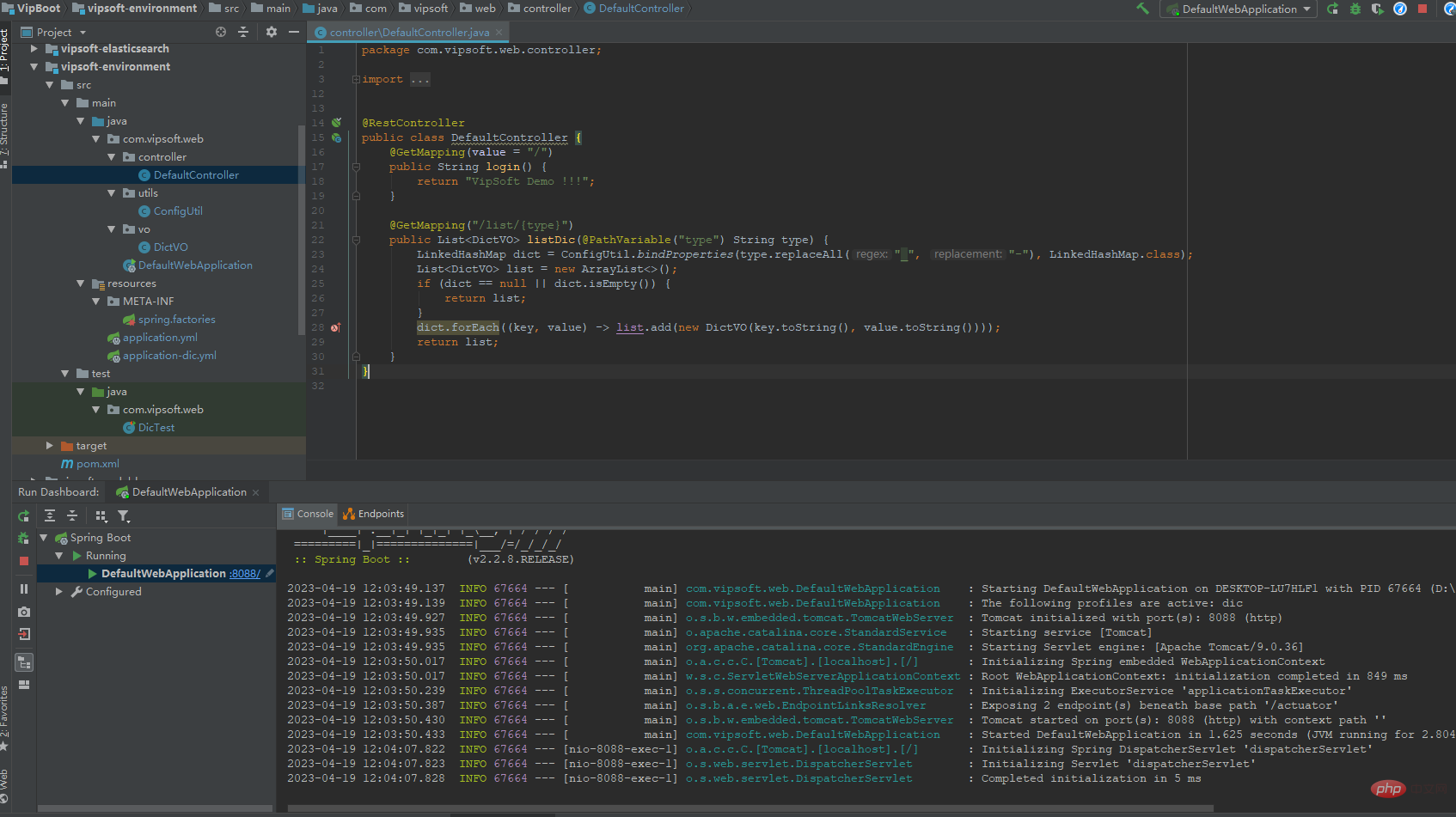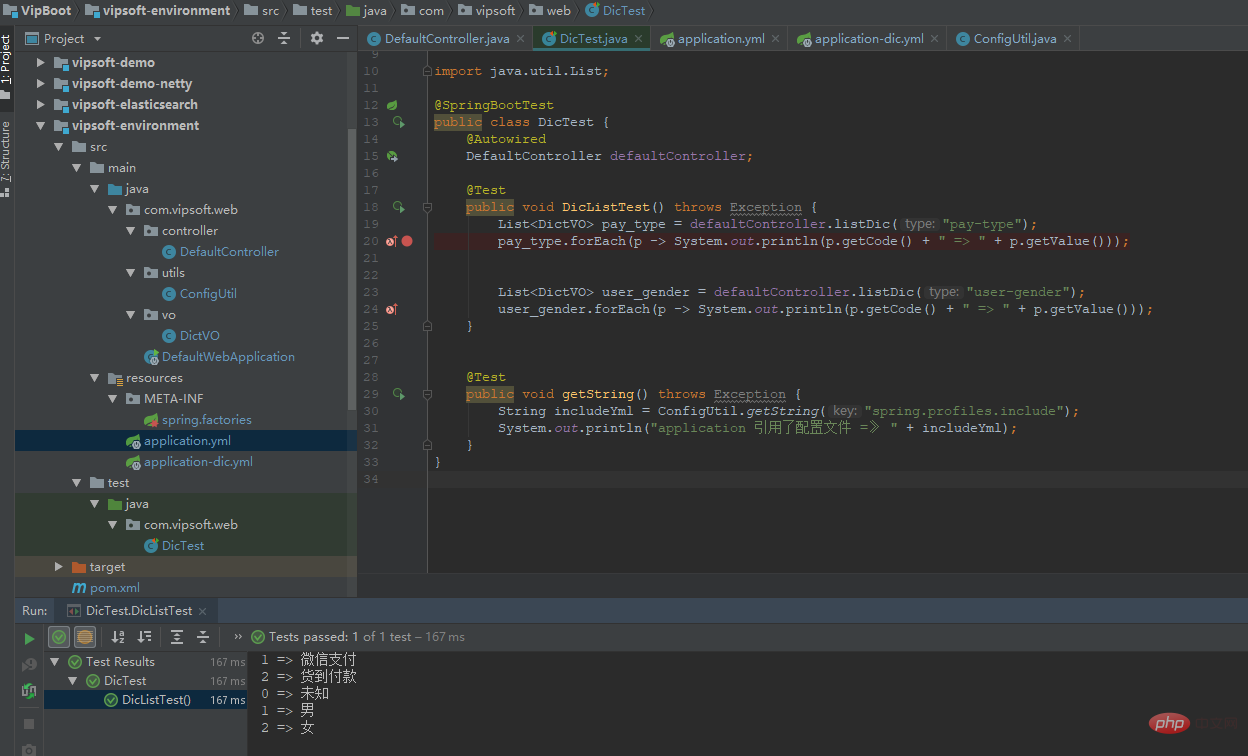How does SpringBoot load dictionary data in yml files?
Configure the dictionary data in the yml file, and load the data into the Map by loading the yml
The yml configuration in Spring Boot refers to the configuration in other yml. # Create a new application-xxx
in the configuration file directory (such as resources). The yml file must start with application. Multiple files are separated by "," and cannot be newline
Project structure file

application.yml
server:
port: 8088
application:
name: VipSoft Env Demo
spring:
profiles:
include:
dic # 在配置文件目录(如:resources)下新建application-xxx 开头的yml文件, 多个文件用 "," 号分隔,不能换行
#性别字典
user-gender:
0: 未知
1: 男
2: 女application-dic.yml
Change the dictionary Independently into a separate yml file
#支付方式 pay-type: 1: 微信支付 2: 货到付款
In the resources directory, create the META-INF directory and create the spring.factories file,
Spring Factories is a mechanism similar to Java SPI. It configures the implementation class name of the interface in the META-INF/spring.factories file, and then reads these configuration files and instantiates them in the program.
The content is as follows:
# Environment Post Processor org.springframework.boot.env.EnvironmentPostProcessor=com.vipsoft.web.utils.ConfigUtil
ConfigUtil
package com.vipsoft.web.utils;
import org.springframework.boot.SpringApplication;
import org.springframework.boot.context.properties.bind.BindResult;
import org.springframework.boot.context.properties.bind.Binder;
import org.springframework.boot.env.EnvironmentPostProcessor;
import org.springframework.core.env.ConfigurableEnvironment;
import org.springframework.core.env.PropertySource;
import org.springframework.util.Assert;
public class ConfigUtil implements EnvironmentPostProcessor {
private static Binder binder;
private static ConfigurableEnvironment environment;
public static String getString(String key) {
Assert.notNull(environment, "environment 还未初始化!");
return environment.getProperty(key, String.class, "");
}
public static <T> T bindProperties(String prefix, Class<T> clazz) {
Assert.notNull(prefix, "prefix 不能为空");
Assert.notNull(clazz, "class 不能为空");
BindResult<T> result = ConfigUtil.binder.bind(prefix, clazz);
return result.isBound() ? result.get() : null;
}
/**
* 通过 META-INF/spring.factories,触发该方法的执行,进行环境变量的加载
*/
@Override
public void postProcessEnvironment(ConfigurableEnvironment environment, SpringApplication application) {
for (PropertySource<?> propertySource : environment.getPropertySources()) {
if (propertySource.getName().equals("refreshArgs")) {
return;
}
}
ConfigUtil.environment = environment;
ConfigUtil.binder = Binder.get(environment);
}
}DictVo
package com.vipsoft.web.vo;
public class DictVO implements java.io.Serializable {
private static final long serialVersionUID = 379963436836338904L;
/**
* 字典类型
*/
private String type;
/**
* 字典编码
*/
private String code;
/**
* 字典值
*/
private String value;
public DictVO(String code, String value) {
this.code = code;
this.value = value;
}
public String getType() {
return type;
}
public void setType(String type) {
this.type = type;
}
public String getCode() {
return code;
}
public void setCode(String code) {
this.code = code;
}
public String getValue() {
return value;
}
public void setValue(String value) {
this.value = value;
}
}DefaultController
package com.vipsoft.web.controller;
import com.vipsoft.web.utils.ConfigUtil;
import com.vipsoft.web.vo.DictVO;
import org.springframework.web.bind.annotation.GetMapping;
import org.springframework.web.bind.annotation.PathVariable;
import org.springframework.web.bind.annotation.RestController;
import java.util.ArrayList;
import java.util.LinkedHashMap;
import java.util.List;
@RestController
public class DefaultController {
@GetMapping(value = "/")
public String login() {
return "VipSoft Demo !!!";
}
@GetMapping("/list/{type}")
public List<DictVO> listDic(@PathVariable("type") String type) {
LinkedHashMap dict = ConfigUtil.bindProperties(type.replaceAll("_", "-"), LinkedHashMap.class);
List<DictVO> list = new ArrayList<>();
if (dict == null || dict.isEmpty()) {
return list;
}
dict.forEach((key, value) -> list.add(new DictVO(key.toString(), value.toString())));
return list;
}
}Running effect

Unit Test
package com.vipsoft.web;
import com.vipsoft.web.controller.DefaultController;
import com.vipsoft.web.utils.ConfigUtil;
import com.vipsoft.web.vo.DictVO;
import org.junit.jupiter.api.Test;
import org.springframework.beans.factory.annotation.Autowired;
import org.springframework.boot.test.context.SpringBootTest;
import java.util.List;
@SpringBootTest
public class DicTest {
@Autowired
DefaultController defaultController;
@Test
public void DicListTest() throws Exception {
List<DictVO> pay_type = defaultController.listDic("pay-type");
pay_type.forEach(p -> System.out.println(p.getCode() + " => " + p.getValue()));
List<DictVO> user_gender = defaultController.listDic("user-gender");
user_gender.forEach(p -> System.out.println(p.getCode() + " => " + p.getValue()));
}
@Test
public void getString() throws Exception {
String includeYml = ConfigUtil.getString("spring.profiles.include");
System.out.println("application 引用了配置文件 =》 " + includeYml);
}
}
The above is the detailed content of How does SpringBoot load dictionary data in yml files?. For more information, please follow other related articles on the PHP Chinese website!

Hot AI Tools

Undresser.AI Undress
AI-powered app for creating realistic nude photos

AI Clothes Remover
Online AI tool for removing clothes from photos.

Undress AI Tool
Undress images for free

Clothoff.io
AI clothes remover

Video Face Swap
Swap faces in any video effortlessly with our completely free AI face swap tool!

Hot Article

Hot Tools

Notepad++7.3.1
Easy-to-use and free code editor

SublimeText3 Chinese version
Chinese version, very easy to use

Zend Studio 13.0.1
Powerful PHP integrated development environment

Dreamweaver CS6
Visual web development tools

SublimeText3 Mac version
God-level code editing software (SublimeText3)

Hot Topics
 How Springboot integrates Jasypt to implement configuration file encryption
Jun 01, 2023 am 08:55 AM
How Springboot integrates Jasypt to implement configuration file encryption
Jun 01, 2023 am 08:55 AM
Introduction to Jasypt Jasypt is a java library that allows a developer to add basic encryption functionality to his/her project with minimal effort and does not require a deep understanding of how encryption works. High security for one-way and two-way encryption. , standards-based encryption technology. Encrypt passwords, text, numbers, binaries... Suitable for integration into Spring-based applications, open API, for use with any JCE provider... Add the following dependency: com.github.ulisesbocchiojasypt-spring-boot-starter2. 1.1Jasypt benefits protect our system security. Even if the code is leaked, the data source can be guaranteed.
 How SpringBoot integrates Redisson to implement delay queue
May 30, 2023 pm 02:40 PM
How SpringBoot integrates Redisson to implement delay queue
May 30, 2023 pm 02:40 PM
Usage scenario 1. The order was placed successfully but the payment was not made within 30 minutes. The payment timed out and the order was automatically canceled. 2. The order was signed and no evaluation was conducted for 7 days after signing. If the order times out and is not evaluated, the system defaults to a positive rating. 3. The order is placed successfully. If the merchant does not receive the order for 5 minutes, the order is cancelled. 4. The delivery times out, and push SMS reminder... For scenarios with long delays and low real-time performance, we can Use task scheduling to perform regular polling processing. For example: xxl-job Today we will pick
 How to use Redis to implement distributed locks in SpringBoot
Jun 03, 2023 am 08:16 AM
How to use Redis to implement distributed locks in SpringBoot
Jun 03, 2023 am 08:16 AM
1. Redis implements distributed lock principle and why distributed locks are needed. Before talking about distributed locks, it is necessary to explain why distributed locks are needed. The opposite of distributed locks is stand-alone locks. When we write multi-threaded programs, we avoid data problems caused by operating a shared variable at the same time. We usually use a lock to mutually exclude the shared variables to ensure the correctness of the shared variables. Its scope of use is in the same process. If there are multiple processes that need to operate a shared resource at the same time, how can they be mutually exclusive? Today's business applications are usually microservice architecture, which also means that one application will deploy multiple processes. If multiple processes need to modify the same row of records in MySQL, in order to avoid dirty data caused by out-of-order operations, distribution needs to be introduced at this time. The style is locked. Want to achieve points
 How to solve the problem that springboot cannot access the file after reading it into a jar package
Jun 03, 2023 pm 04:38 PM
How to solve the problem that springboot cannot access the file after reading it into a jar package
Jun 03, 2023 pm 04:38 PM
Springboot reads the file, but cannot access the latest development after packaging it into a jar package. There is a situation where springboot cannot read the file after packaging it into a jar package. The reason is that after packaging, the virtual path of the file is invalid and can only be accessed through the stream. Read. The file is under resources publicvoidtest(){Listnames=newArrayList();InputStreamReaderread=null;try{ClassPathResourceresource=newClassPathResource("name.txt");Input
 How to implement Springboot+Mybatis-plus without using SQL statements to add multiple tables
Jun 02, 2023 am 11:07 AM
How to implement Springboot+Mybatis-plus without using SQL statements to add multiple tables
Jun 02, 2023 am 11:07 AM
When Springboot+Mybatis-plus does not use SQL statements to perform multi-table adding operations, the problems I encountered are decomposed by simulating thinking in the test environment: Create a BrandDTO object with parameters to simulate passing parameters to the background. We all know that it is extremely difficult to perform multi-table operations in Mybatis-plus. If you do not use tools such as Mybatis-plus-join, you can only configure the corresponding Mapper.xml file and configure The smelly and long ResultMap, and then write the corresponding sql statement. Although this method seems cumbersome, it is highly flexible and allows us to
 How SpringBoot customizes Redis to implement cache serialization
Jun 03, 2023 am 11:32 AM
How SpringBoot customizes Redis to implement cache serialization
Jun 03, 2023 am 11:32 AM
1. Customize RedisTemplate1.1, RedisAPI default serialization mechanism. The API-based Redis cache implementation uses the RedisTemplate template for data caching operations. Here, open the RedisTemplate class and view the source code information of the class. publicclassRedisTemplateextendsRedisAccessorimplementsRedisOperations, BeanClassLoaderAware{//Declare key, Various serialization methods of value, the initial value is empty @NullableprivateRedisSe
 Comparison and difference analysis between SpringBoot and SpringMVC
Dec 29, 2023 am 11:02 AM
Comparison and difference analysis between SpringBoot and SpringMVC
Dec 29, 2023 am 11:02 AM
SpringBoot and SpringMVC are both commonly used frameworks in Java development, but there are some obvious differences between them. This article will explore the features and uses of these two frameworks and compare their differences. First, let's learn about SpringBoot. SpringBoot was developed by the Pivotal team to simplify the creation and deployment of applications based on the Spring framework. It provides a fast, lightweight way to build stand-alone, executable
 3 ways for SpringBoot to read yml files
Jun 29, 2023 pm 11:25 PM
3 ways for SpringBoot to read yml files
Jun 29, 2023 pm 11:25 PM
The main ways SpringBoot reads yml files are as follows: 1. @Value annotation We can use the @Value annotation on the properties of the bean to directly read the value in yml, such as: application.yml:name:ZhangsanBean:publicclassMyBean{ @Value("${name}")privateStringname;}2.Environment object We can read the yml value by injecting the Environment object, such as: @AutowiredprivateEnvironmentenv






